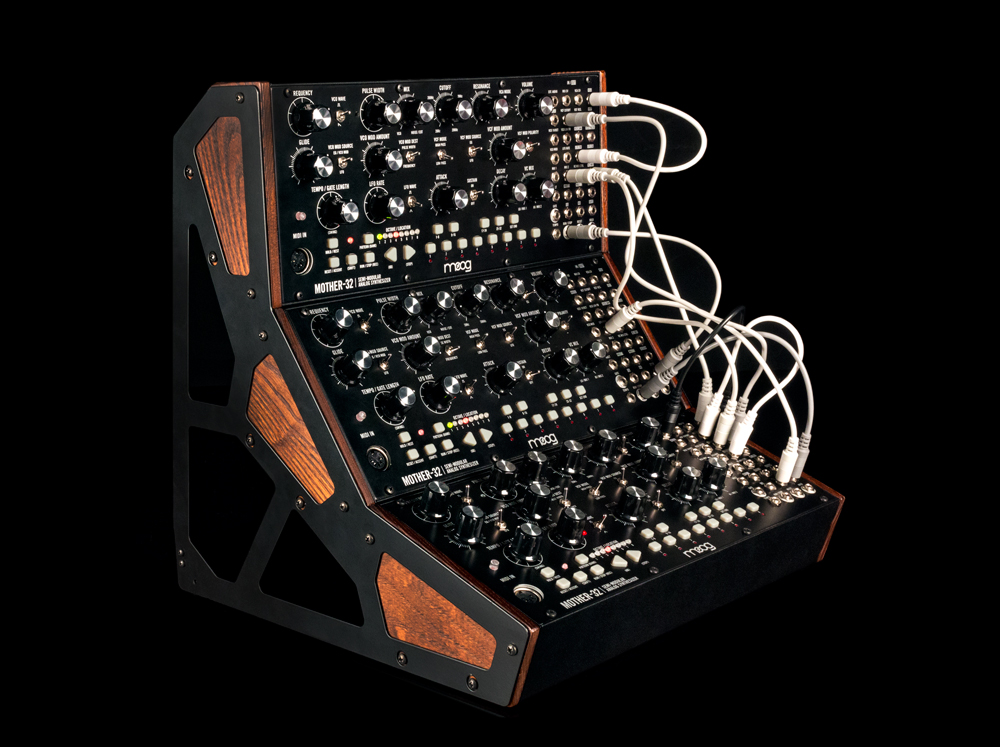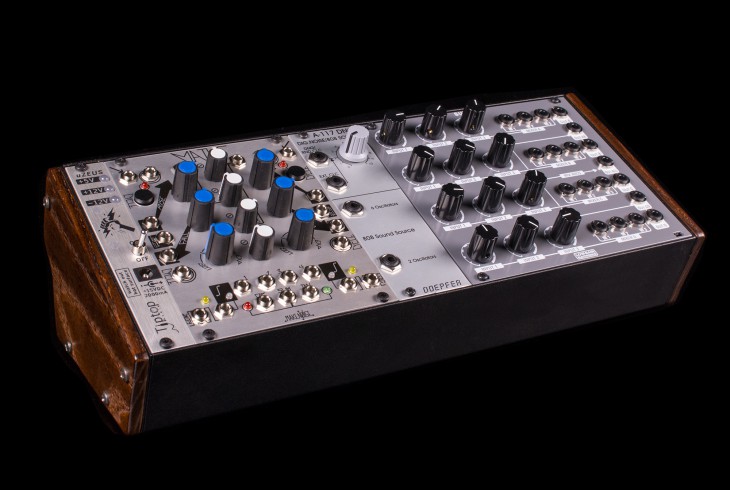Du verwendest einen veralteten Browser. Es ist möglich, dass diese oder andere Websites nicht korrekt angezeigt werden.
Du solltest ein Upgrade durchführen oder einen alternativen Browser verwenden.
Du solltest ein Upgrade durchführen oder einen alternativen Browser verwenden.
snowcrash
|||
Zweiter Poti von oben, links. Slides vermutlich in Kombination mit dem Parameter [Hold].orgo schrieb:Wo versteckt sich Glide?
orgo
|||
snowcrash schrieb:Zweiter Poti von oben, links. Slides vermutlich in Kombination mit dem Parameter [Hold].
 hoffentlich lässt sich Glide auch pro Step einstellen.
hoffentlich lässt sich Glide auch pro Step einstellen.stromzuton
..
bartleby
lieber nicht.
das waere freilich schick. ich erwarte es erstmal eher nicht, lasse mich aber gern positiv ueberraschen.orgo schrieb:hoffentlich lässt sich Glide auch pro Step einstellen.
darsho
Sö Sünteßeisör !
bartleby
lieber nicht.
Crabman
|||||||||||
Fr@nk
||||||||||
Yep ist nur schaltbar ... ob man die noch über die separaten Outs sinnvoll mischen kann bleibt aber noch zu prüfen.darsho schrieb:der VCO scheint nur umschaltbar zu sein bei den Wellenformen aber nicht stufenlos wie z.B. beim Slim Phatty.
Das finde ich dann doch ein bisschen schade.
[dunkel]
||||
bartleby
lieber nicht.
ok, offenbar gibts tatsaechlich programmierbare slides (so bei 02:30).[dunkel] schrieb:

bartleby
lieber nicht.
witzig, dass moog jetzt auch eurorack-gehaeuse anbietet.
fuer meinen geschmack ist die optik allerdings etwas zu rustikal:


fuer meinen geschmack ist die optik allerdings etwas zu rustikal:


Optional Mother Accessories [...]
- 2 Tier Mother Rack Kit (Also for use with 60 HP Moog case)
- 3 Tier Mother Rack Kit (Also for use with 60 HP Moog case)
- 60 HP Empty Moog Eurorack Case (Requires Eurorack power module for use)
bartleby
lieber nicht.
und noch die specks:
VOLTAGE CONTROLLED OSCILLATOR
Single VCO with simultaneous Sawtooth and Pulse wave Outputs (+/-5V)
1 V/Octave from 8Hz to 8KHz (16KHz max with LFO/CV)
Panel Frequency control (+/-1 Octave)
Toggle Selector for waveform routed to the mixer
Pulse Width control
Linear FM and 1V/Octave Exponential FM inputs (+/-5V)
NOISE
Output normalled to Ext Audio input
White Noise output (+/-5V)
VOLTAGE CONTROLLED MIXER
Crossfades between selected VCO waveform and Ext Audio input (normalled to White Noise)
Mix CV input (+/-5V)
VOLTAGE CONTROLLED FILTER
20Hz to 20KHz switchable Low Pass/High Pass 4-pole Transistor Ladder Filter with voltage controlled Resonance
VCF Cutoff input (+/-5V)
VCF Resonance input (+/-5V)
VCF Output (+/-5V)
VOLTAGE CONTROLLED AMPLIFIER
Selectable CV Source: EG or ON (drone)
VCA CV input (0 to +8V in EG mode and +/-5V in ON mode, summed with signals from ON/EG switch)
Output Volume Control (VCA Out and Line/Headphone Out)
VCA output (+/-5V) and rear panel 1/4" Headphone/Audio Output (+/-1.7V peak)
LOW FREQUENCY OSCILLATOR
Square wave output (+/-5V)
Triangle wave output (+/-5V)
Selectable waveshape to VCO and VCF MOD sections
Panel Rate control .1Hz to 350Hz (600Hz max)
LFO Rate CV input (+/-5V)
ENVELOPE GENERATOR
Variable controls for Attack and Decay
Sustain ON/OFF for single-trigger (ASD) or multi-trigger (AD) behavior
External Gate input (0 to +5V; Tolerant of 10V gates)
EG output (0 to +7.5V)
VCO MODULATION
Selectable Source: EG/VCO MOD or LFO (EG normalled to VCO MOD in)
VCO Mod input (normalled to EG/VCO MOD switch position)
Variable Modulation Amount control
Selectable Modulation Destination: VCO Pitch or PWM (PWM summed with Pulse Width panel control)
VCF MODULATION
Selectable Source: EG or LFO
Variable Modulation Amount control
Selectable VCF Modulation Polarity (+/-)
VOLTAGE CONTROLLED MIXER/ATTENUATOR
Voltage controlled crossfade/mix circuit for mixing two DC coupled signals
Mix 1 Input (Normalled to ground)
Mix 2 Input (Normalled to +5V)
Mix Control CV input (-5V to +5V)
Mix Output: Un-inverted output (-5 to +5V)
MULTIPLE
1x input 2x output signal multiplier
Mult Input: Buffered signal
Mult Outputs: 1 and 2
KEYBOARD
Single octave 13-note keyboard (In Step Edit Mode this is used to select, mute and enable sequencer steps.)
Octave Up/Down buttons select from 8 available octave settings
Glide Time control
KB CV output (-5 to +5V)
Gate Output (0 to +5V)
SEQUENCER
Dual-mode 32 step sequencer with 64 sequence locations
Performance Modes:
- In KB Mode, the Keyboard is used to play the instrument, enter sequence data and transpose sequences.
- In Step Mode, the keyboard functions as the step sequencer interface and is used to enable and mute steps, update note data and select sequence banks.
Each sequence step includes: Note Value, Gate Length (Tie), Rest On/Off, Accent On/Off, Glide On/Off and Ratchet count (up to 4 note-repeats occurring in the duration of a single note)
Sequencer Panel Controls: Tempo, Swing, Run/Stop, Hold, and Reset
Sequencer Control Inputs: Tempo, Run/Stop (also used for sync), Reset and Hold
Sequencer Control Outputs: KB, Gate, Accent Pulse
PATCHBAY
The patchbay contains 32 patch points (3.5mm)
Available Inputs: External Audio, Mix CV, VCA CV, VCF Cutoff, VCF Resonance, VCO 1V/Octave, VCO Linear FM, VCO Modulation, LFO Rate, Mix 1, Mix 2, VC Mix Control, Mult, Gate, Tempo, Run/Stop, Reset and Hold
Available Outputs: VCA, Noise, VCF, VCO Saw, VCO Pulse, LFO Triangle, LFO Square, VC Mix, Mult 1, Mult 2, Assign, EG, KB, Gate
ASSIGNABLE OUTPUT
• Multipurpose control output for selecting from 16 available functions: Sequencer Accent, Sequencer Clock, Sequencer Clock /2 Sequencer Clock /4, Decimated "Ramp”, Decimated "Saw”, Decimated "Triangle”, Stepped Random, STEP 1, MIDI Note On Velocity, MIDI Channel Aftertouch, MIDI Pitch Bend, MIDI CC1 Mod Wheel, MIDI CC2, MIDI CC4 and MIDI CC7
SPECS
• Dimensions: 12.57“W x 4.21“H (with knobs) x 5.24“D
• Weight: 3.5 lbs.
• Power Consumption: 2.8W
• Included Power Supply: 100-250VAC, 50-60Hz, +12VDC 1A
• Patchbay: 32x 3.5mm jacks
• Rear Panel Audio Out: ¼” Headphone / Audio
EURORACK SPECS
• Current Draw: 230mA (+12V – from 10-pin header)
• Mounting Dims: 60HP (.69” 26mm Module Depth)
bartleby
lieber nicht.
bingo! aus dem handbuch (sequencer tutorial, seite 21):orgo schrieb:hoffentlich lässt sich Glide auch pro Step einstellen.
und programmierbare 'ratchets' kann der sequencer offenbar auch:TURNING GLIDE ON/OFF
To turn Glide ON for a step, simply turn the GLIDE control to the right.
Octave/Location LED 5 is lit green indicating Glide is turned ON for the current step.
To turn Glide OFF for a step, simply turn the GLIDE control all the way down.
NOTE: Glide rate is not set per-step and is always determined by the front panel GLIDE control.
Hold (SHIFT) while turning the GLIDE control. Octave/Location LEDs 1-4 will temporarily light yellow, indicating the number of Ratchets (repeats) in the current step. Select a value of 2, which will produce 2 notes during the step (up to 4 can be selected). Octave/Location LED 6 is lit green to indicate a Ratchet value greater than 1.
NOTE: Ratcheted steps are easier to hear if their Gate Length is set to a lower value.
Sven Blau
temporarily logged off, permanently
stuartm
|| | | | |
Kalt
||||
M
MMMM
Guest
Bitte schön !
...ohne Effekthascherei und ohne Pinzette bedienbar
https://m.soundcloud.com/moogmusicinc/s ... nd-samples
...ohne Effekthascherei und ohne Pinzette bedienbar

https://m.soundcloud.com/moogmusicinc/s ... nd-samples
siebenachtel
|||||||||||
die demos sind gut, aber drei kisten kosten dann 1800$Kalt schrieb:600$ ist doch mal was ,.... gefällt mir ,...
..........finde die ganzen demos so gesehen ein bisschen "hingeflunkert".
vom Hall ganz abgesehen.........
600.- ist ein hammer preis, keine frage.
aber ich stehe unter dem eindruck das es in dem fall die kundennähere strategie gewesen wäre nicht primär auf den preis zu fahren sondern das etwas besser auszustatten und halt etwas teurer zu machen.
fanwander
************************
Naja, ein MS20 hat bei Erst-Erscheinen auch nicht viel mehr gekostet ... (wenn wir Euro 1:2 zu DM nehmen).siebenachtel schrieb:600.- ist ein hammer preis, keine frage.
snowcrash
|||
Pfuh, das Teil schaut schon sehr interessant aus... harte Zeiten, fürs Konto.
Was ich gut an dem Teil finde, ist, dass da alles in einer Box daherkommt. Gut, die reduzierten Features, nur ein OSC, aber gerade als Sequence-Schleuder macht das sogar sehr viel Sinn, wer braucht für Arpeggien schon 2x ADSR? Der Sequencer wirkt mehr als komplett.
Eigentlich eine grosse Überraschung, mit dem hätte ich bei Moog nicht mehr gerechnet.
Was ich gut an dem Teil finde, ist, dass da alles in einer Box daherkommt. Gut, die reduzierten Features, nur ein OSC, aber gerade als Sequence-Schleuder macht das sogar sehr viel Sinn, wer braucht für Arpeggien schon 2x ADSR? Der Sequencer wirkt mehr als komplett.
Eigentlich eine grosse Überraschung, mit dem hätte ich bei Moog nicht mehr gerechnet.

klangsulfat
SYS 64738
Nope. Weil der Mutter ein zweiter Oszillator fehlt. Ist für dicke Moog-Bässe essenziell.maffyn schrieb:kleine frage: sparte der kauf dieses teiles den erwerb eines minitaur vollkommen? (also: kann der genausogut Bass?)
M
MMMM
Guest
klangsulfat schrieb:Nope. Weil der Mutter ein zweiter Oszillator fehlt. Ist für dicke Moog-Bässe essenziell.maffyn schrieb:kleine frage: sparte der kauf dieses teiles den erwerb eines minitaur vollkommen? (also: kann der genausogut Bass?)
jepp,...zumindest wäre ein SUB hilfreich.
P.S.: Die Samples die ich oben verlinkt habe, sind alle von einer Mutter 32 nicht von Dreien !
dns370
..
M
MMMM
Guest
dns370 schrieb:Tut das so weh, wenn nur ein OSC dabei ist?
Was wird das Teil wohl hier in Europa kosten? €799?
1. Quatsch!...Moog kann Bässe sogar ohne OSC, ich finde Schwingungen werden überbewertet
2. Da habe ich auch noch ein Fragezeichen auf dem Kopf, sollten die nicht 599,-€ kosten?
Ähnliche Themen
- Antworten
- 0
- Aufrufe
- 663
News
-
News Umsturz 2026 - SequencerTalk 264 - die letzte in diesem Jahr - live
- Gestartet von Moogulator
- Antworten: 1
-
News 2025-12-20 Shiny Toys, Dortmund - Musik Festival Reihe IV
- Gestartet von Moogulator
- Antworten: 1
-
-
News CRYPTOBIOSIS (Performance-Musik-Mikrobiologie) - in Köln
- Gestartet von Moogulator
- Antworten: 0
-
-
-
News Next-Generation MIDI Controller kommen - eine ganze Ladung
- Gestartet von Moogulator
- Antworten: 1
App installieren
So wird die App in iOS installiert
Folge dem Video um zu sehen, wie unsere Website als Web-App auf dem Startbildschirm installiert werden kann.
Anmerkung: Diese Funktion ist in einigen Browsern möglicherweise nicht verfügbar.
